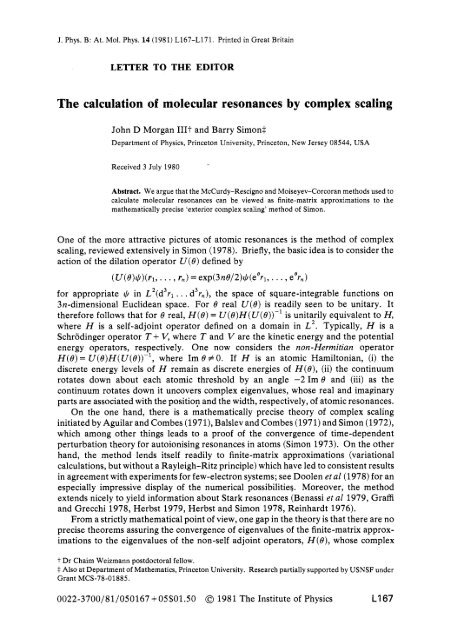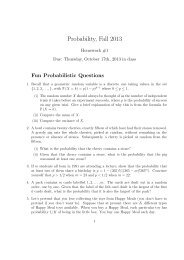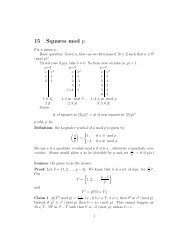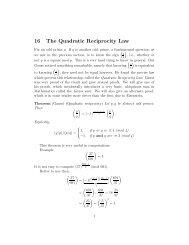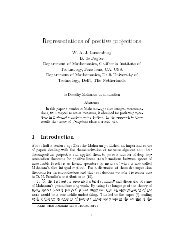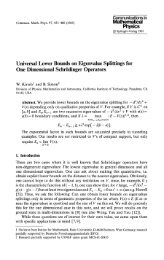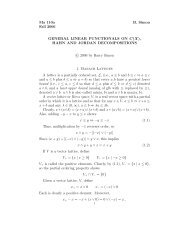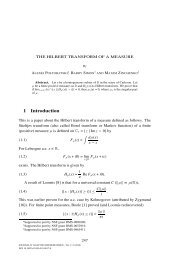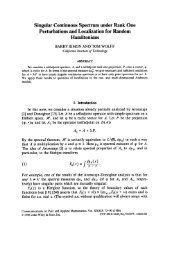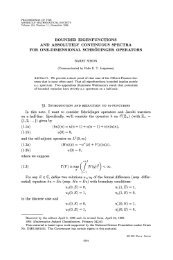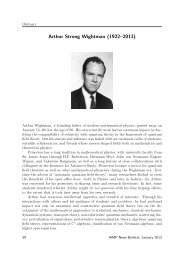The calculation of molecular resonances by complex scaling
The calculation of molecular resonances by complex scaling
The calculation of molecular resonances by complex scaling
Create successful ePaper yourself
Turn your PDF publications into a flip-book with our unique Google optimized e-Paper software.
J. Phys. B: At. Mol. Phys. 14 (1981) L167-Ll71. Printed in Great Britain<br />
LETTER TO THE EDITOR<br />
<strong>The</strong> <strong>calculation</strong> <strong>of</strong> <strong>molecular</strong> <strong>resonances</strong> <strong>by</strong> <strong>complex</strong> <strong>scaling</strong><br />
John D Morgan IIIt and Barry Simon$<br />
Department <strong>of</strong> Physics, Princeton University, Princeton, New Jersey 08544, USA<br />
Received 3 July 1980<br />
Abstract. We argue that the McCurdy-Rescigno and Moiseyev-Corcoran methods used to<br />
calculate <strong>molecular</strong> <strong>resonances</strong> can be viewed as finite-matrix approximations to the<br />
mathematically precise 'exterior <strong>complex</strong> <strong>scaling</strong>' method <strong>of</strong> Simon.<br />
One <strong>of</strong> the more attractive pictures <strong>of</strong> atomic <strong>resonances</strong> is the method <strong>of</strong> <strong>complex</strong><br />
<strong>scaling</strong>, reviewed extensively in Simon (1978). Briefly, the basic idea is to consider the<br />
action <strong>of</strong> the dilation operator U(8) defined <strong>by</strong><br />
(u(e)$)(rl, . . . , rn) = exp(3ne/2)4(eer1, I . . , eern)<br />
for appropriate 4 in L2(d3rl . . . d3r,,), the space <strong>of</strong> square-integrable functions on<br />
3n-dimensional Euclidean space. For 8 real U(8) is readily seen to be unitary. It<br />
therefore follows that for 8 real, H(8) = U(O)H(U(8))-' is unitarily equivalent to H,<br />
where H is a self-adjoint operator defined on a domain in L2. Typically, H is a<br />
Schrodinger operator T + V, where T and V are the kinetic energy and the potential<br />
energy operators, respectively. One now considers the non-Hermitian operator<br />
H(8)= U(e)H(U(O))-', where Im 8#0. If H is an atomic Hamiltonian, (i) the<br />
discrete energy levels <strong>of</strong> H remain as discrete energies <strong>of</strong> H(8), (ii) the continuum<br />
rotates down about each atomic threshold <strong>by</strong> an angle -2 Im 8 and (iii) as the<br />
continuum rotates down it uncovers <strong>complex</strong> eigenvalues, whose real and imaginary<br />
parts are associated with the positiov and the width, respectively, <strong>of</strong> atomic <strong>resonances</strong>.<br />
On the one hand, there is a mathematically precise theory <strong>of</strong> <strong>complex</strong> <strong>scaling</strong><br />
initiated <strong>by</strong> Aguilar and Combes (1971), Balslev and Combes (1971) and Simon (1972),<br />
which among other things leads to a pro<strong>of</strong> <strong>of</strong> the convergence <strong>of</strong> time-dependent<br />
perturbation theory for autoionising <strong>resonances</strong> in atoms (Simon 1973). On the other<br />
hand, the method lends itself readily to finite-matrix approximations (variational<br />
<strong>calculation</strong>s, but without a Rayleigh-Ritz principle) which have led to consistent results<br />
in agreement with experiments for few-electron systems; see Doolen et a1 (1978) for an<br />
especially impressive display <strong>of</strong> the numerical possibilitieg. Moreover, the method<br />
extends nicely to yield information about Stark <strong>resonances</strong> (Benassi et a1 1979, Graffi<br />
and Grecchi 1978, Herbst 1979, Herbst and Simon 1978, Reinhardt 1976).<br />
From a strictly mathematical point <strong>of</strong> view, one gap in the theory is that there are no<br />
precise theorems assuring the convergence <strong>of</strong> eigenvalues <strong>of</strong> the finite-matrix approximations<br />
to the eigenvalues <strong>of</strong> the non-self adjoint operators, H(8), whose <strong>complex</strong><br />
t Dr Chaim Weizmann postdoctoral fellow.<br />
t Also at Department <strong>of</strong> Mathematics, Princeton University. Research partially supported <strong>by</strong> USNSF under<br />
Grant MCS-78-01885.<br />
0022-3700/81/050167 +05$01.50 @ 1981 <strong>The</strong> Institute <strong>of</strong> Physics L167
L168 Letter to the Editor<br />
eigenvalues are the resonance energies. We raise this point because this gap prevents<br />
our arguments below from being rigorous theorems. We emphasise that in the atomic<br />
case, there is extensive numerical evidence for rapid convergence <strong>of</strong> the matrix<br />
approximations (see e.g. Doolen 1978) although in the Stark problem some apparent<br />
<strong>resonances</strong> have disappeared under passage to larger matrices.<br />
This note concerns the extension <strong>of</strong> the method to <strong>molecular</strong> <strong>resonances</strong>, a subject<br />
on which there has recently been considerable discussion (McCurdy 1980, McCurdy<br />
and Rescigno 1978, Moiseyev and Corcoran 1979, Simon 1979). For a variety <strong>of</strong><br />
reasons (see especially McCurdy and Rescigno 1978 and also Simon 1979) one wants to<br />
obtain resonance curves in a fixed nucleus (Born-Oppenheimer) approximation as<br />
functions <strong>of</strong> nuclear positions; that is, one only wants to scale electron coordinates and<br />
not nuclear coordinates. Unfortunately, for R fixed, V(r) = /r -RI-' is not dilation<br />
analytic; the singularity at r = R blossoms into a circle <strong>of</strong> square-root branch points in<br />
V(eer) for 8 non-real; see Simon (1978). This difficulty can also be seen <strong>by</strong> doing the<br />
<strong>complex</strong> <strong>scaling</strong> in momentum space. If V(r) = Irl-', Q(p) = 4n--p/-'. Thus if VR(r) =<br />
Ir -RI-', QR(p) = exp(-ip * R) 4.rrlpl-'. In momentum space VR acts as<br />
If 4 is replaced with eieq, where 0 < 8 < n-, the kernel <strong>of</strong> the integral operator has<br />
exponential growth at infinity, with the result that VR(ei'r)$(eier) is not even defined for<br />
a reascnable $ such as the 1s eigenfunction <strong>of</strong> the hydrogen atom, where<br />
Two seemingly distinct approaches have been proposed to overcome these<br />
difficulties. An approach dubbed 'exterior <strong>complex</strong> <strong>scaling</strong>' has been presented <strong>by</strong><br />
Simon (1979, 1981) which only scales the electron coordinates outside some large<br />
sphere. This method is mathematically precise and has most <strong>of</strong> the nice mathematical<br />
properties <strong>of</strong> ordinary <strong>complex</strong> <strong>scaling</strong>, but it seems to be difficult to implement in<br />
<strong>calculation</strong>s. Two related ad hoc methods <strong>of</strong> <strong>calculation</strong> have been proposed <strong>by</strong><br />
McCurdy (1980), McCurdy and Rescigno (1978) and Moiseyev and Corcoran (1979).<br />
To oversimplify the proposals, we can describe them as explicit realisations <strong>of</strong> an ad hoc<br />
procedure suggested earlier <strong>by</strong> Yaris et a1 (1978). If the usual <strong>complex</strong> <strong>scaling</strong> theory<br />
works and if I,,$ is a dilation analytic vector, then<br />
where +(e) = U(e)+ and H(B) = U(O)H(U(O))-*.<br />
<strong>The</strong> proposal is then to use the<br />
right-hand side <strong>of</strong> equation (1) to obtain finite-matrix approximations to a non-existent<br />
'H(6)' in cases where H(B) is not meaningful. Of course, in general this can be a<br />
dangerous procedure: for example using inverse scattering methods, one can construct<br />
potentials for which the scattering amplitude will have a natural boundary as the real<br />
axis is approached. However, the above method will 'predict' resonance energies in<br />
such a situation where there is no second sheet.<br />
One point <strong>of</strong> the exterior <strong>scaling</strong> theory is to guarantee the existence <strong>of</strong> a second<br />
sheet at least for matrix elements <strong>of</strong> the resolvent between dilation analytic vectors. Our<br />
purpose here is to explain why the eigenvalues <strong>of</strong> the McCurdy-Rescigno and<br />
Moiseyev-Corcoran methods can be viewed as finite-matrix approximations to the
Letter to the Editor L169<br />
positions <strong>of</strong> these second sheet poles. It is our hope that this realisation <strong>of</strong> a firm<br />
mathematical foundation will encourage further <strong>calculation</strong>s with these methods.<br />
For each E > 0, let g, be the three-dimensional Gaussian<br />
which as EJO approximates a 6 function. Let<br />
J<br />
This convolution technique is known as the Weierstrass transform and has been studied<br />
extensively (Hirschmann and Widder 1955). In general, the Weierstrass transform<br />
maps functions f(x) with dxf(x) exp(-cu 1x1') < 03 to analyticfunctions. Thus, for each<br />
E > 0, ~'"'(r) is an entire function <strong>of</strong> r; explicitly,<br />
where erf(r) is the error function, defined <strong>by</strong><br />
16<br />
erf(z) = 2?r-'l2 dt exp(-t').<br />
<strong>The</strong> smoothing effect <strong>of</strong> the Weierstrass transform is easily seen in momentum<br />
space: the singular kernel with exponential growth at infinity<br />
is replaced <strong>by</strong><br />
477 exp[-i(p -e-"q) ~ ] / / -e-ieq12 p<br />
which for 0 < IIm 81 < ?r/4 has exponential fall <strong>of</strong>f as q becomes large. Now fix some<br />
nuclear positions, R1, . . . , Rk and let H'"' denote the electron Hamiltonian for these<br />
nuclear positions with all Coulomb potentials Ix - y1-l replaced <strong>by</strong> V'"'(x - y). For<br />
Ro> maxi IRjl, one can consider the exterior scaled Hamiltonian Hk: (8) described in<br />
Simon (1979, 1981). For IIm el
L170 letter to the Editor<br />
one accepts finite-matrix approximations <strong>of</strong> dilation analytic problems, one should<br />
assume that<br />
E$) ~E(") as N+m.<br />
If we make the further reasonable leap <strong>of</strong> faith that this last convergence is uniform in E,<br />
then one has that<br />
EN+E<br />
i.e. the <strong>complex</strong> eigenvalues <strong>of</strong> the McCurdy-Rescigno and Moiseyev-Corcoran<br />
methods should converge to the <strong>resonances</strong> defined <strong>by</strong> exterior <strong>complex</strong> <strong>scaling</strong>.<br />
To summarise; we view the methods <strong>of</strong> McCurdy (1980), McCurdy and Rescigno<br />
(1978) and Moiseyev and Corcoran (1979) as clever finite-matrix approximations to the<br />
precise mathematical theory <strong>of</strong> Simon (1979), and this view is supported <strong>by</strong> the<br />
apparent stability as N is increased in the <strong>calculation</strong>s in McCurdy (1980), McCurdy<br />
and Rescigno (1978) and Moiseyev and Corcoran (1979). It seems to us that this type <strong>of</strong><br />
finite-matrix approximation is about as firmly based as the kind <strong>of</strong> approximation used<br />
in ordinary <strong>complex</strong> <strong>scaling</strong> in atomic systems.<br />
Thus far we have discussed only electron-molecule <strong>resonances</strong>. <strong>The</strong> same Weier-<br />
strass transform technique works also for <strong>resonances</strong> <strong>of</strong> molecules in an external<br />
constant electric field. This fact is quite trivial, for the convolution <strong>of</strong> any linear function<br />
with the three-dimensional Gaussian (equation (2)) is precisely the same linear<br />
function.<br />
We would like to thank Stephen Scheinberg for introducing us to the Weierstrass<br />
transform.<br />
Notes added in pro<strong>of</strong>. After this article was submitted we saw two papers (Deguchi K and Nishikawa K 1980 J.<br />
Phys. B: At. Mol. Phys. 13 L511-4, L515-8), which relate the Gaussian convolution technique to the<br />
generator coordinate method (Lathouwers L, van Leuven P and Bouten M 1977 Chem. Phys. Lett. 52 439).<br />
R Junker (1981 Phys. Rev. Lett. to appear) has proposed a different way, exploiting the variational<br />
principle, <strong>of</strong> making the connection between exterior <strong>complex</strong> <strong>scaling</strong> and the <strong>calculation</strong> methods <strong>of</strong><br />
McCurdy, Rescigno, Moiseyev and Corcoran.<br />
References<br />
Aguilar S and Combes J M 1971 Commun. Math. Phys. 22 265<br />
Balslev E and Combes J M 1971 Commun. Math. Phys. 22 280<br />
Benassi L, Grecchi V, Harrell E and Simon B 1979 Phys. Rev. Lett. 42 704<br />
Doolen G 1978 Int. J. Quantum Chem. (Proc. 1977 Sanibel Workshop on Complex Scaling) 14 523<br />
Doolen G, Nutall J and Wherry C S 1978 Phys. Rev. Lett. 40 818<br />
Graffi S and Grecchi V 1978 Commun. Math. Phys. 62 83<br />
Herbst I1979 Commun. Math. Phys. 64 279<br />
Herbst I and Simon B 1978 Phys. Rev. Lett. 41 67<br />
Hirschmann I and Widder D 1955 <strong>The</strong> Convolution Transform (Princeton: Princeton University Press) ch 8<br />
Kat0 T 1976 Perturbation <strong>The</strong>ory for Linear Operators (Berlin: Springer)<br />
McCurdy C W 1980 Phys. Rev. A 21 464<br />
McCurdy C W and Rescigno T N 1978 Phys. Rev. Lett. 41 1364<br />
Moiseyev N and Corcoran C 1979 Phys. Rev. A 20 814<br />
Reed M and Simon B 1978 Methods<strong>of</strong>ModernMathematicalPhysics: Analysis<strong>of</strong> Operators vo14 (New York:<br />
Academic)<br />
Reinhardt W 1976 Int. J. Quantum Chem. 10 359
Letter to the Editor<br />
Simon B 1972 Commun. Math. Phys. 27 1<br />
- 1913 Ann. Math. 97 247<br />
- 1918 Int. J. Quantum Chem. (Proc. 1977 Sanibel Workshop on Complex Scaling) 14 529<br />
_. 1979 Phys. Lett. 71A 211<br />
- 1981 to be submitted<br />
Yaris R, Bendler J, Lovett R, Bender C and Fedders P 1978 Phys. Rev. A 18 1816<br />
L171


